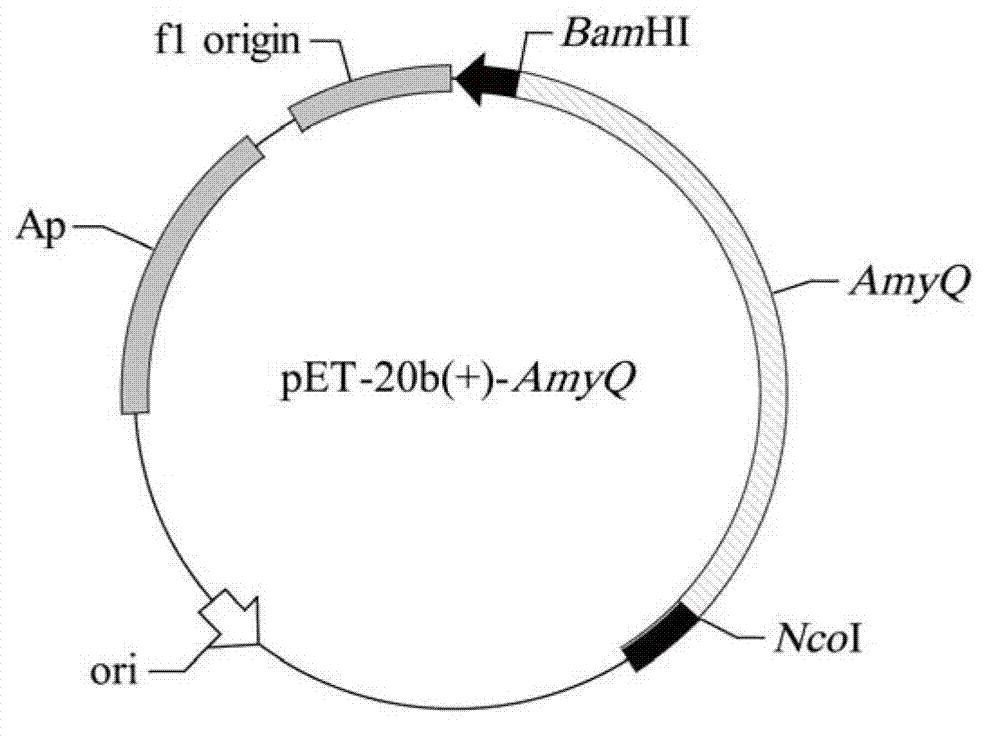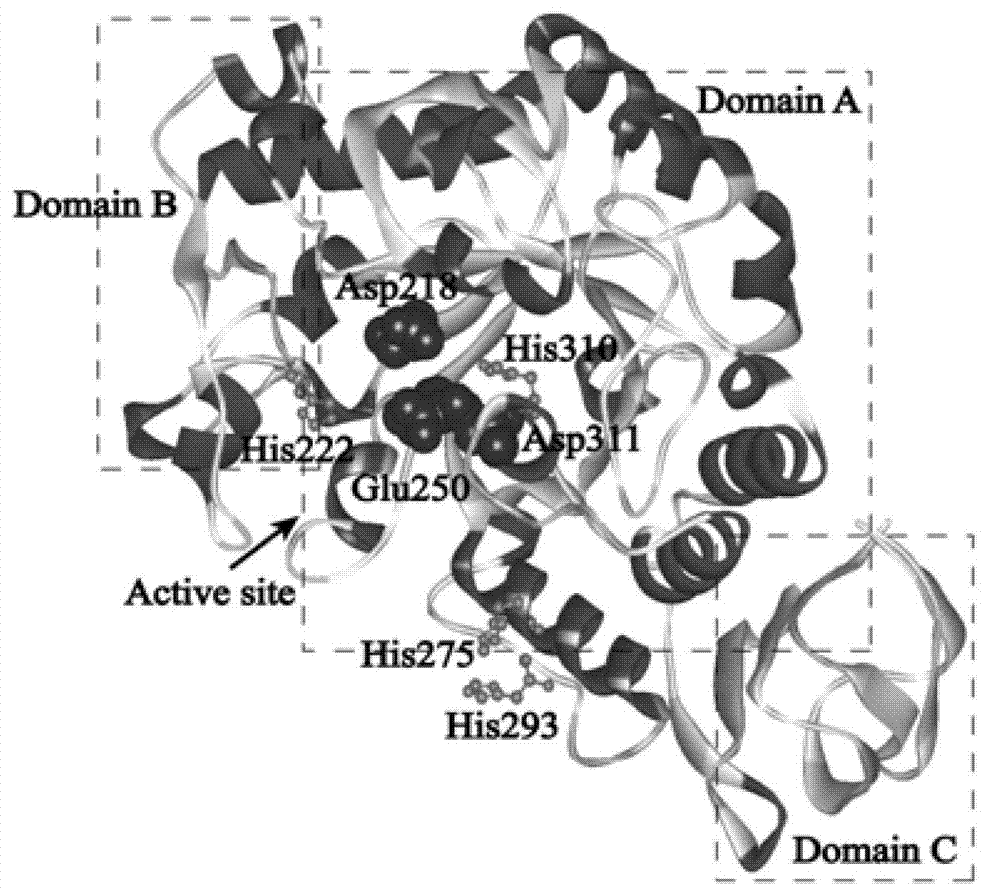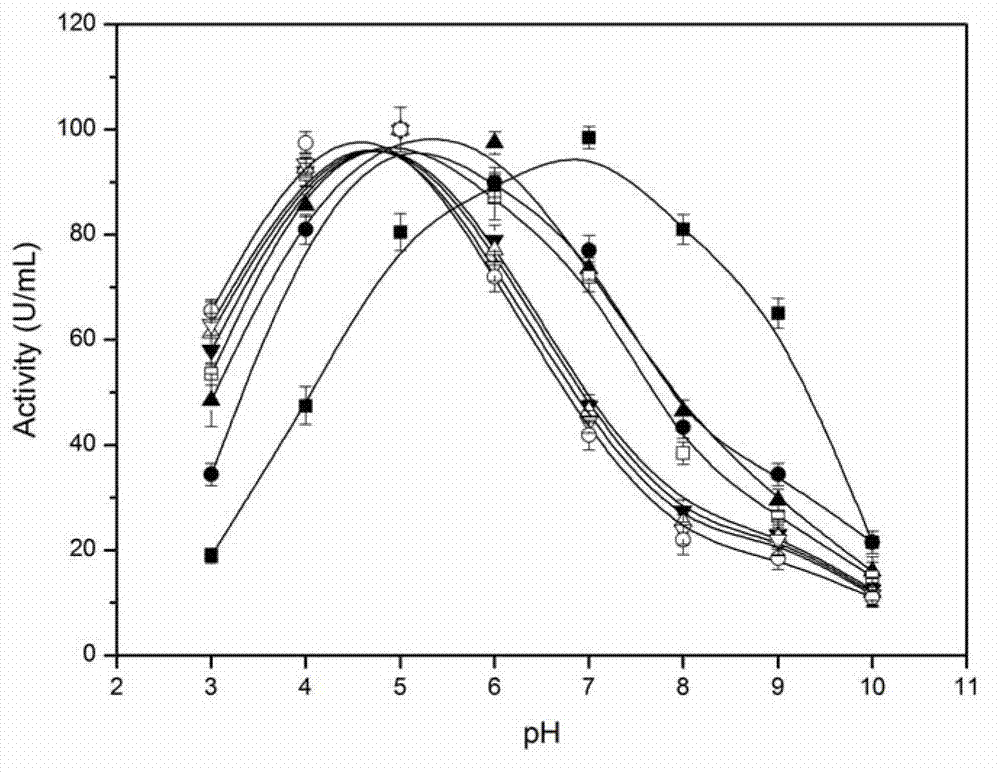Acid-resistant amylase mutant, and preparation method and application thereof
A technology of amylase and mutants, which is applied in the field of acid-resistant amylase mutants and their preparation, can solve the problems of difficulty in obtaining target strains and large blindness, and achieve the effects of shortening the transformation time, strong acid resistance, and efficient degradation
- Summary
- Abstract
- Description
- Claims
- Application Information
AI Technical Summary
Problems solved by technology
Method used
Image
Examples
Embodiment 1
[0021] Example 1: Analysis and method of acid-resistant site-directed mutation of amylase
[0022] By analyzing the 3D spatial structure of amylase ( figure 2 ) analysis to determine the histidine residues (His222, His275, His293, His310) in the catalytic region that are unstable to acid resistance of the enzyme.
[0023] According to the amylase sequence of Bacillus subtilis, the amylase was fully synthesized by chemical total synthesis, and then cloned into the plasmid pET-20b(+) to construct the recombinant plasmid pAmyQ.
[0024] For the site-directed mutagenesis of different His sites, design the corresponding site-directed mutagenesis primers (Table 1). Using site-directed mutagenesis primers, amylase was used for site-directed mutagenesis. PCR enzyme was used to amplify the recombinant plasmid pAmyQ with mutant primers. The amplified fragments were recovered and purified using a gel recovery kit. The obtained purified fragments were phosphorylated at both ends of t...
Embodiment 2
[0025] Example 2: Analysis and method of acid-resistant site-directed mutation of amylase
[0026] Determination of Alkaline Amylase Activity by DNS Method
[0027] 1) DNS reagent configuration: Weigh 2.5g of 3,5-dinitrosalicylic acid and dissolve it in a small amount of water, add 0.5g of phenol, then dissolve 0.075g of sodium sulfite, 2.5g of sodium hydroxide, and 50g of potassium sodium tartrate, and transfer it to Put it into a 500mL volumetric flask, shake it up to volume, store it in a brown bottle and place it in a refrigerator at 4°C until use.
[0028] 2) Preparation of maltose standard curve: Prepare maltose solutions with different concentrations from 0.2g / L to 1.0g / L. Take 1mL of different concentrations of maltose and mix it with the same volume of DNS solution, put it in a boiling water bath, and keep the water bath for 10min. Cool with cold water, dilute to 10mL, A 540 Measure the absorbance. Take the concentration of maltose as the abscissa and the absorban...
Embodiment 3
[0033] Example 3: Determination and Analysis of Catalytic Efficiency of Amylase under Acid Resistance Conditions (pH4.5)
[0034] The recombinant amylase after acid-resistant site-directed mutation was tested for its catalytic efficiency at pH 4.5. Under the condition of citric acid buffer at pH 4.5, mix the buffer with soluble amylase, and use the method in 3) to measure the catalytic efficiency of amylase (k cat ). It was found by measuring that the catalytic efficiencies (k cat ) from the original 2.1×10 2 the s -1 respectively grow to 4.7×, 5.3× and 6.0×10 2 the s -1 ; Catalytic efficiency (k cat ) from the original 2.1×10 2 the s -1 respectively increased to 5.8×, 8.7×, 9.8× and 10.7×10 2 the s -1 . The amylase has strong acid resistance and high catalytic efficiency under acidic conditions.
[0035]
[0036]
[0037]
[0038]
[0039]
[0040]
[0041]
PUM
 Login to View More
Login to View More Abstract
Description
Claims
Application Information
 Login to View More
Login to View More - R&D
- Intellectual Property
- Life Sciences
- Materials
- Tech Scout
- Unparalleled Data Quality
- Higher Quality Content
- 60% Fewer Hallucinations
Browse by: Latest US Patents, China's latest patents, Technical Efficacy Thesaurus, Application Domain, Technology Topic, Popular Technical Reports.
© 2025 PatSnap. All rights reserved.Legal|Privacy policy|Modern Slavery Act Transparency Statement|Sitemap|About US| Contact US: help@patsnap.com



